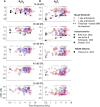Responses to dichotic tone-in-noise stimuli in the inferior colliculus
- PMID: 36532285
- PMCID: PMC9751415
- DOI: 10.3389/fnins.2022.997656
Responses to dichotic tone-in-noise stimuli in the inferior colliculus
Abstract
Human listeners are more sensitive to tones embedded in diotic noise when the tones are out-of-phase at the two ears (N0Sπ) than when they are in-phase (N0S0). The difference between the tone-detection thresholds for these two conditions is referred to as the binaural masking level difference (BMLD) and reflects a benefit of binaural processing. Detection in the N0Sπ condition has been explained in modeling studies by changes in interaural correlation (IAC), but this model has only been directly tested physiologically for low frequencies. Here, the IAC-based hypothesis for binaural detection was examined across a wide range of frequencies and masker levels using recordings in the awake rabbit inferior colliculus (IC). IAC-based cues were strongly correlated with neural responses to N0Sπ stimuli. Additionally, average rate-based thresholds were calculated for both N0S0 and N0Sπ conditions. The rate-based neural BMLD at 500 Hz matched rabbit behavioral data, but the trend of neural BMLDs across frequency differed from that of humans.
Keywords: binaural cues; binaural detection; binaural masking level difference; interaural correlation; midbrain.
Copyright © 2022 Fan, Henry and Carney.
Conflict of interest statement
The authors declare that the research was conducted in the absence of any commercial or financial relationships that could be construed as a potential conflict of interest.
Figures









References
Grants and funding
LinkOut - more resources
Full Text Sources
Research Materials
Miscellaneous

